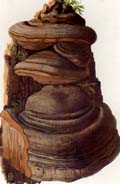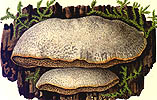
Hoof-shaped to round fruiting bodies growing singly or in troops
Sometimes covering most of a substrate, but never clustered or compound
Mossoporus Subtribe
 Key to Gilled Mushrooms Key
Key to Gilled Mushrooms Key Polyporaceae Family
Polyporaceae Family Small Sessilopolypore Subtribe
Small Sessilopolypore SubtribeSmall Hoof Polypore SemiTribe Hoof-shaped to round fruiting bodies growing singly or in troops | Links from Look-alikes Mossoporus Subtribe Fruiting body hard or tough |
 Glossary |  Mushrooms |  |  People |  Newsletter |  Events |